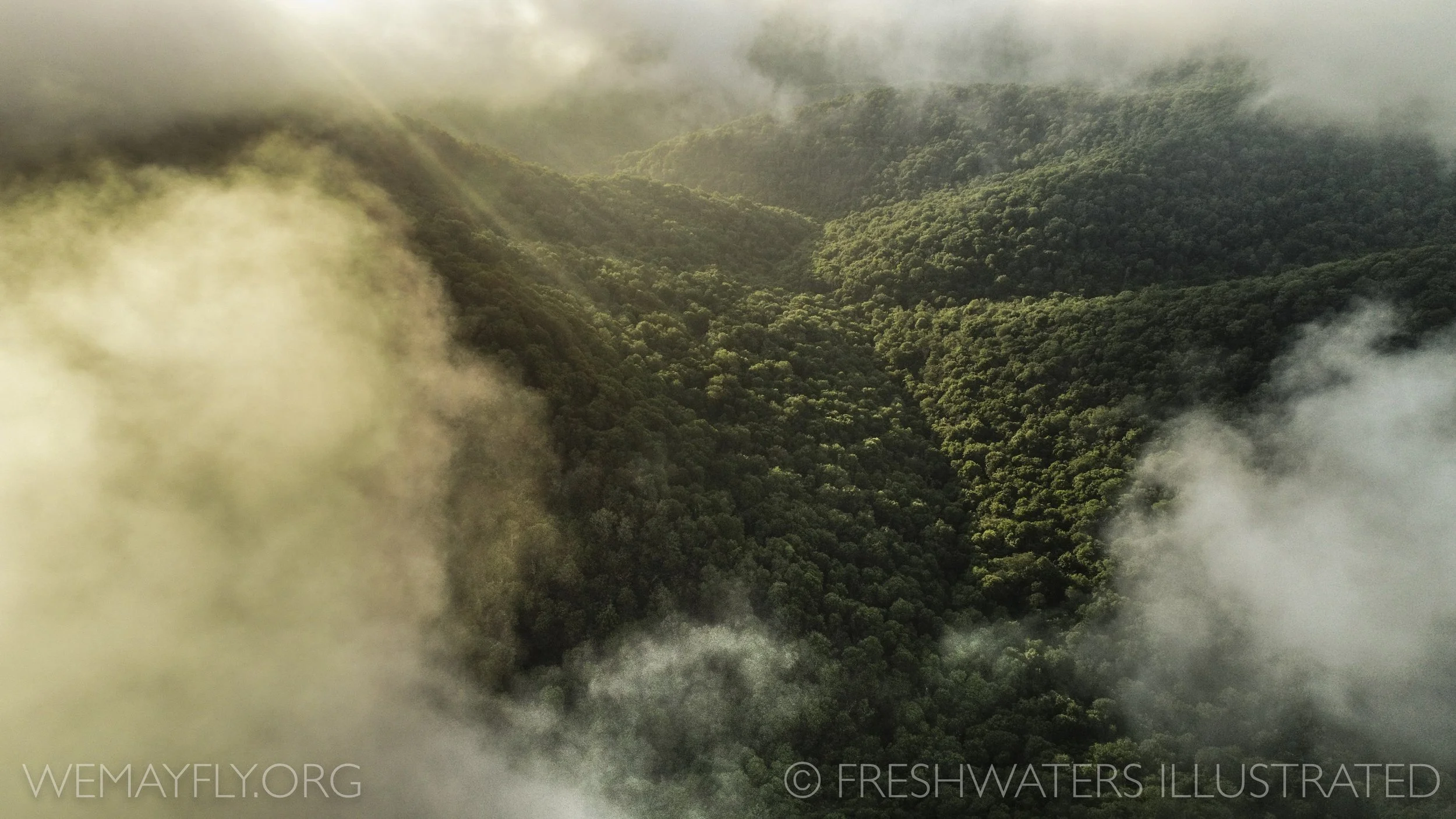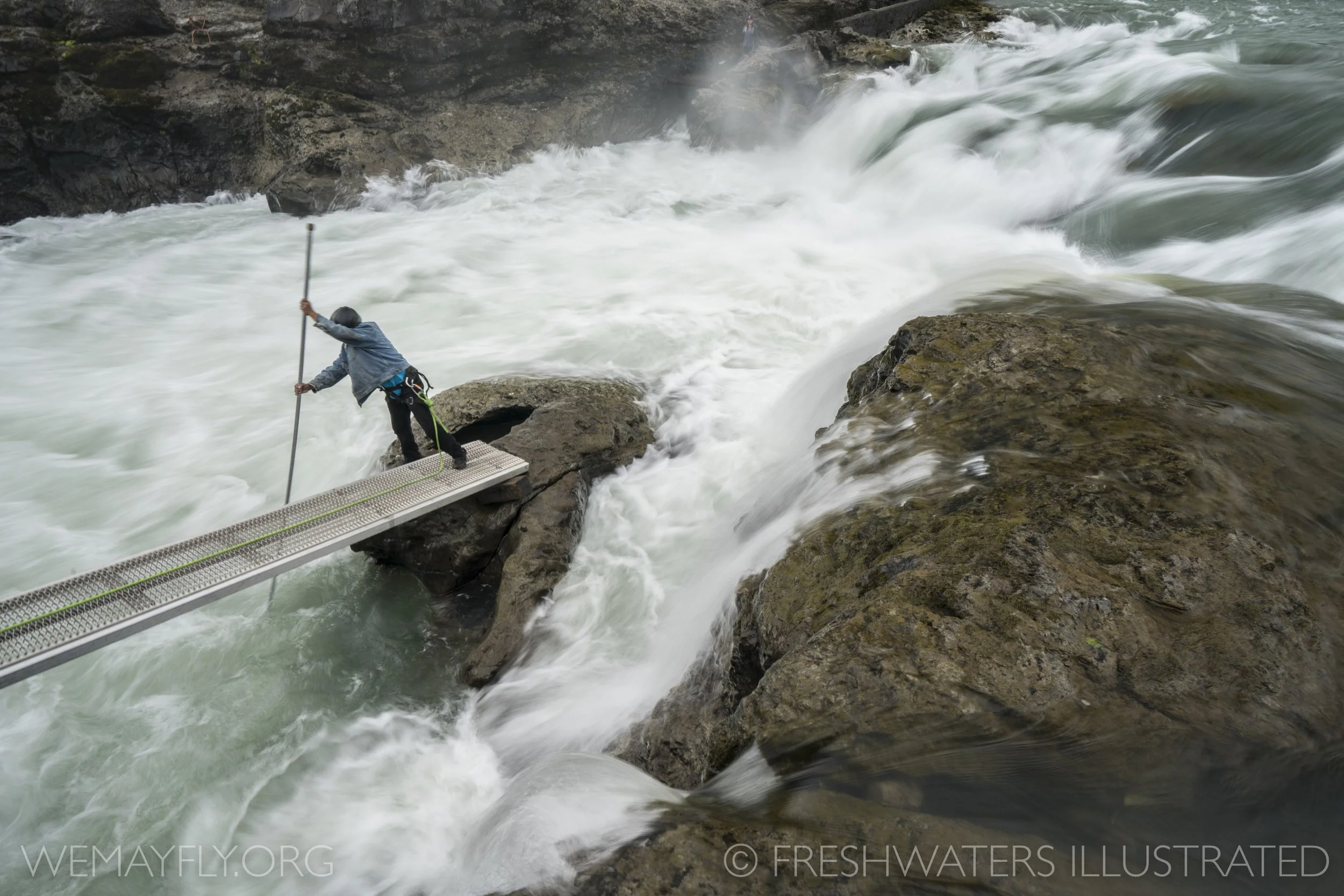SMOLT for High School Students
Overview
SMOLT (3:43) brings us into a story of salmon migration. Many of us are already familiar with the extraordinary migration of adult fish, such as Salmon and Steelhead, from the ocean to freshwater streams to spawn. But there is another migration that receives much less attention: The out migration of the young of those spawning adults—the smolt—moving from their natal (birthplace) streams to the ocean. "Smolt" is a life stage similar to being a teenager. The fish are transforming physiologically and facing many new challenges as they leave sheltered waters for the ocean. This is also a story of the critical habitats salmon depend on for nurseries and transit hubs: the small streams, mighty rivers, rich estuaries, riparian (along waterways) forests, and vast ocean. Lastly, this is a story of us, and whether we celebrate salmon or not, we all are nourished by them.
We invite you to use multiple lenses to explore the following guiding question for SMOLT: In what ways are salmon, people and rivers interconnected? We also invite you to create the next chapter for this story, not by writing it, but by taking actions that support the flourishing of people and salmon. You'll find ideas for action at the end of this guide.
Let's Begin.
Things to think about (Outcomes)
At the end of the lesson, you will know more about yourself, other people and nature, and will be able to:
describe how people, culture, smolt, and rivers are interconnected using the lenses of scientific inquiry, social science, structure and function and personal reflection.
communicate knowledge of a career in fisheries.
express greater self-awareness of personal connections to the health of rivers, estuaries and riparian ecosystems.
conduct a scientific investigation.
demonstrate knowledge of how to use scientific literature, video, and vetted online sites to gather, synthesize and present information.
Photo: Aerial view of a healthy forested valley.
Vocabulary
Listen for these words while watching the video, and use the context to figure out what they mean":
Out migration
Smolt
Estuary
Nursery Habitat
Biomass
Photo: A migratory corridor with a healthy riparian forest. Notice how the forest extends to the edges of the river.
Please watch the video using the fullscreen setting.
Film Discussion
Take a moment to process what you just watched. Then, when you are ready, please continue.
What did you notice in this film?
What did you wonder about while watching this film?
What connections did you make?
Record all of these and we'll return to them later.
Respond to one of these quotes from the movie, using any format. If you can gather into a group to discuss and present one to the rest of your classmates, even better:
"Pacific salmon are a living symbol of migration, and the journeys many animals must make to survive"
"How important river estuaries are as nursery habitats for young salmon smolts to feed and grow before they move into the open ocean."
"How large river estuaries act as transit hubs for scores of smolt from unique populations."
"How the size and migration timing of each young salmon will control whether it is one of the few that will survive to make the return journey"
"Because it is these tiny silvery salmon, that if estuaries and other habitats critical to the salmon lifecycle are protected and restored, will someday return as adults to shape the next generation, and will continue to nourish ecosystems, people, and cultures."
The Lens of Science & English Language Arts
Recommended but optional, research.
Step 1: Select researchable ideas you wondered about and recorded earlier, and shape into questions that have the potential to yield useful findings. These findings might expand the story of salmon as we know it!
Step 2: Work with your teacher and classmates to develop logical, scientific procedures and launch investigations. (We have a separate guide for this if you need it)
Step 3: When finished, share and discuss your findings.
THE LENS OF SCIENCE: NGSS Cross Cutting Concept Structure & Function
Overview
In SMOLT we learned that each spring, 300 million 3.4 inch silvery fish from 50 different populations travel 440 km down a river into an estuary in 10 days, and then head into the ocean where they will spend the next 2-5 years. Pause for a moment to reflect on that and these next questions, which you'll explore in the activity. What physiological changes occur in the smolt that enables them to transition from living in freshwater to salt water? How does traveling in a school protect them? What impact do they have on the river system, including on other species? (consider sheer biomass)
Activity
Using the resources provided below, find out what is known about how the smolt make this journey from river to estuary to the sea. Portray this journey using any creative format. Be sure to:
identify and label physiological and morphological (form or structure) changes
label interactions and relationships with other species
label direction of energy flow with arrows
Include an explanation of impacts: why this quiet, hidden journey is so significant to the estuary, people, ecosystems, and culture. Remember to include yourself.
Resources
Jonathan Moore, Salmon Watershed Lab, Simon Fraser University, B.C.
The Salmon Life Cycle from the National Park Service
Salmon Watch Series (21:21)
The Lens of History
Write a one page essay or develop a mini-podcast in which you compare the perspective and knowledge of smolt you had before and after watching this film. In your essay, include a comparison of your experience with that of members of Lake Babine Nation, who celebrate the smolt journey with the Invisible Migration ceremony. Share it!
Photo: Lake Babine Nation
The Lens of Social Emotional Learning & English Language Arts
Use any media format to accurately compare your life as a teen with the life of the smolt. Consider: What connections can you make between your life and that of the smolts' as you navigate the milestones, adventures, learning and missteps of this exciting and terrifying transition into adulthood?
Photo: Each spring, 300 million 3.4 inch silvery fish from 50 different populations head to the Skeena Estuary, BC. Similar out migration is happening in healthy streams, rivers, and estuaries throughout the Pacific Northwest, including streams in your communities.
The Lens of Personal Reflection
In what ways are salmon, people, and rivers interconnected?
Using the question we started with (above) as a reference, create a high quality recording, detailed drawing, poem, written paragraph or piece of art to summarize the following:
how your thinking, feelings, attitudes, or perspectives have been changed by learning this story
how you will use what you learned outside of school
Photo: An example of a healthy stream habitat. Notice the clean gravel stream bed and plants shading the stream to keep the water cool. Cool water holds more oxygen than warm water.
Ideas For Action
“Sometimes it is hard to realize in the moment what the impact of what
you are doing or what other people are doing will be in the future . . . .
What we do now is going to affect this place for generations to come, and
what do we want that impact to be?”
Individual and collective actions matter, and have impact. They can also be a lot of fun! Here are some achievable things you can do to teach about and protect critical habitats.
Advocate for Justice & Equity in all things
Create Compelling Stories to Teach Others:
Public Service Announcements on Social Media
Flyers
Cartoons
Videos
Assemblies
Interviews
Podcasts
Guides to Place history
Your wildly magical suggestion
Go outside or look out windows and be curious. There is a whole world waiting for you!
Green Schoolyards
Plant gardens for people & wildlife
Set up no mow areas
Address runoff and erosion with green infrastructure projects
Get certified as a green school
Create guides to green infrastructure in your schoolyards
Redo transportation
Consider and research a GREEN Career. It is a growing field!
Know where the food you eat comes from, how and where it is grown and what happens to the leftovers. We can each have a big impact by making small changes in food consumption decisions. Here is one solution to inspire you!
Observe and reconsider Individual, school, and school district food choices
Participate with others in a local, national, or international youth-led organization, or start one in your community. Here are some ideas to get you started. (Copy and paste titles into a search engine to access the most current websites).
Climate Justice Alliance
Earth Force
Earth Guardians
Global Youth Action Network
Greta Thunberg “Friday’s for Future”
Grey to Green
HIP HOP Caucus
iMATTER Youth - Centered Climate Action
International Youth Climate Movement & YOUNGO
Jane Goodall’s Roots & Shoots
ONE UP ACTION
SustainUS: US Youth For Justice and Sustainability
Sunrise Movement
UN Global Youth Advisory Group on Climate Change
UNICEF Voices of Youth
UPLIFT: Youth Rising for Climate Justice
Youth Climate Lab
Zero Hour
Reduce consumption, learn product lifecycles and the Circular Economy
Observe and reconsider individual and school and school district product consumption choices
Observe and reconsider individual and school and school district transportation choices
Reduce consumption of single use plastics
Your wildly magical suggestions
If you live in Oregon, get to know your local Watershed Council
Participate in volunteer activities
More Freshwaters Illustrated Films About Migration
Water from the Mountain (9 min 36 sec)
Excerpt: Shrimp Inc. (3 min 30 sec)
Of a Greater Power (2 min 41 sec)
The Lost Fish (25 min)
Excerpt: Hanging on (5 min 30 sec)
Bringing Back the Brooks: A revival of the South’s Trout (9 min 16 sec)
Riverwebs (56 min)
Mountain Whitefish (2 min)
For Teachers & Students
NGSS Performance Standards
•HS-LS-2: Evaluate the evidence for the role of group behavior on individual and species’ chances to survive and reproduce.
NGSS Cross Cutting Concepts
•Structure and function: The way in which an object or living thing is shaped and its substructure determine many of its properties and functions.
Social Emotional Learning (SEL from CASEL)
•Self-Awareness: The abilities to understand one’s own emotions, thoughts, and values and how they influence behavior across contexts.
•Responsible decision-making: The abilities to make caring and constructive choices about personal behavior and social interactions across diverse situations
Common Core: History
•WHST.9-12.7 Conduct short as well as more sustained research projects to answer a question (including a self-generated question) or solve a problem; narrow or broaden the inquiry when appropriate; synthesize multiple sources on the subject, demonstrating understanding of the subject under investigation.
Common Core: English Language Arts (ELA)
•WHST.9-12.2 Write informative/explanatory texts, including the narration of historical events, scientific procedures/ experiments, or technical processes
•SL.1-10-12 Initiate and participate effectively in a range of collaborative discussions (one-on-one, in groups, and teacher-led) with diverse partners on grades 11–12 topics, texts, and issues, building on others’ ideas and expressing their own clearly and persuasively.
What will you do to ensure the breathtaking story of salmon continues?
Created March 2, 2023 by Freshwaters Illustrated
Questions or comments? Please send to: kathy@freshwatersillustrated.org












